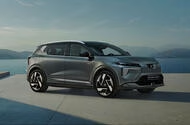What’s New with the 2025 Mitsubishi Eclipse Cross? Here’s What You Need to Know
If you’ve been following the electric car scene, you might have noticed Mitsubishi making some bold moves lately. The latest? The 2025 Mitsubishi Eclipse Cross, which marks a fresh chapter for the brand in Europe—and possibly a return to the UK. But what’s really changed, and why should you care? Let’s break it down.
Why Is Mitsubishi Releasing a Rebadged Renault Scenic?
You might be wondering, why is Mitsubishi’s new electric crossover essentially a Renault Scenic with a different badge? The answer lies in the strategic partnership between Renault, Nissan, and Mitsubishi. This alliance lets the brands share technology and platforms, helping them cut costs and speed up development. For Mitsubishi, this means they can jump back into the European EV market without starting from scratch.
But it’s not just a copy-paste job. Mitsubishi has made sure the Eclipse Cross stands out with its own signature touches—most notably the ‘Dynamic Shield’ grille and unique daytime running lights up front. Around the back, there’s a new gloss black panel tying the rear lights together, giving it a distinct look even if the bones are familiar.
How Does the Eclipse Cross Differ from the Renault Scenic?
On the outside, the differences are subtle but effective. The front grille and lighting give the Eclipse Cross a more aggressive, Mitsubishi-esque face. Inside, you’ll find new seats with diamond-shaped quilting, adding a bit of flair and comfort. Still, the 12.3-inch infotainment touchscreen remains, complete with Apple CarPlay and Android Auto—so you’re not missing out on tech.
Mechanically, though, it’s nearly identical to the Scenic. That means you get an 87kWh nickel-manganese-cobalt battery, which is good for a claimed 372 miles of range (according to WLTP standards). That’s a serious figure—enough to rival some of the best in the segment. Charging is flexible, too: up to 150kW on DC rapid chargers, or 22kW on AC connections if you’re topping up at home or work.
What’s Under the Hood (or Floor)?
Let’s talk power. The Eclipse Cross sends 215bhp and 221lb ft of torque to the rear wheels via a single electric motor. That’s plenty for zippy city driving and comfortable highway cruising. If you’re not looking for maximum range or power, a “medium-range” version is expected next year, likely with a 60kWh battery and a 168bhp motor—making the lineup more accessible to a wider range of drivers.
Where Is the Eclipse Cross Built, and Why Does It Matter?
Production is happening in Douai, France, at a Renault facility. This isn’t just a footnote—it’s a sign of how global carmaking is evolving. By leveraging Renault’s manufacturing expertise and infrastructure, Mitsubishi can focus on design and branding, while keeping costs competitive. It also means the car is built to European standards, which is a plus for buyers concerned about quality and safety.
How Does This Fit into Mitsubishi’s European Strategy?
Mitsubishi’s European lineup has been shrinking in recent years. With the discontinuation of the Space Star (known in the UK as the Mirage), the only Japanese-built model left in Europe is the Outlander. The new Eclipse Cross, then, is a big deal—it’s the brand’s first real shot at reclaiming relevance in a market that’s rapidly shifting toward electrification.
This isn’t Mitsubishi’s first rebadged Renault, either. The Colt is based on the Renault Clio, the ASX on the Captur, and the Grandis on the Symbioz. It’s a clear sign that Mitsubishi is betting on collaboration to stay competitive.
Will Mitsubishi Return to the UK?
This is the million-pound question. Mitsubishi hasn’t confirmed anything yet, but Frank Krol, head of European operations, has said that a UK comeback is under serious consideration. The UK remains a key market for electrified vehicles, and with the right lineup—think the new Eclipse Cross and the Outlander—Mitsubishi could find a receptive audience.
What Do Experts and Data Say About Mitsubishi’s Move?
Industry analysts see this as a smart play. According to the European Automobile Manufacturers Association (ACEA), electric vehicle sales in Europe jumped by over 30% in 2023, and the trend shows no sign of slowing. By leveraging proven Renault tech, Mitsubishi can offer a competitive product without the risk and expense of developing a new EV from scratch.
Real-world feedback on the Renault Scenic platform has been positive, especially regarding range and comfort. If Mitsubishi can add its own reliability and after-sales support, the Eclipse Cross could be a strong contender in the crowded crossover market.
Is the New Eclipse Cross Worth Waiting For?
If you’re in the market for a practical, long-range electric crossover, the Eclipse Cross is shaping up to be a compelling option. It blends European engineering with Japanese design cues, offers impressive range, and is backed by the resources of a major automotive alliance. Plus, with more affordable variants on the horizon, it’s not just for early adopters.
The bottom line? Mitsubishi’s latest move isn’t just about a new badge—it’s about staying relevant in a fast-changing market. Whether you’re a loyal Mitsubishi fan or just EV-curious, the new Eclipse Cross is worth keeping on your radar. And if the brand does make its UK return, expect the competition to heat up even more.

